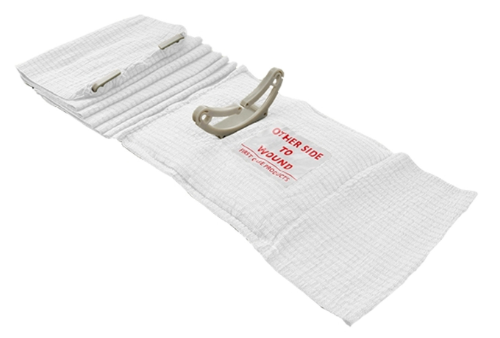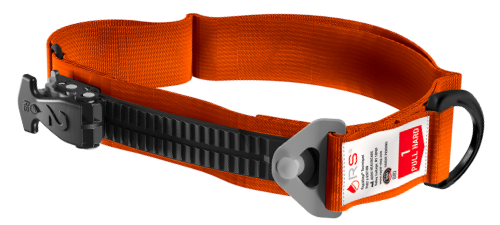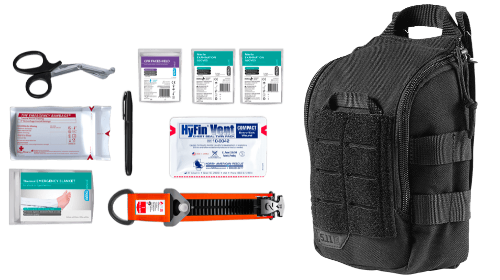Stop The Bleed
Stop The Bleed is an important campaign originally started in the USA by the department of defense in the wake of several mass shootings where civilians have traditionally been unable to help save lives due to a lack of training. Stop the bleed took lessons learned in military combat zones and developed a training protocol that allows everyday civilians to save lives.
Now, mass shootings are few and far between in Australia but they do happen and there are countless other scenarios where the ability to stop blood loss fast will be able to save lives. These scenarios could include:
- Hunting accidents
- Shooting range accidents
- Targeted shootings and collateral damage
- Construction accidents
- Natural disasters
- Flooding
- Earthquake
- Car crashes
- Pedestrian hit by car
- Falling from a height
- Bike crash
- Shark Attack
- Dog Attack
- + Countless others
You may think that the kind of injury that can cause rapid blood loss is rare and unlikely to happen around you, but you would be mistaken, just think about a broken bone, almost everyone has experienced this at some point in their life whether it be personally or a loved one. Well you might think "How would a broken arm lead to rapid blood loss?" Well quite easily, a compound fracture is when the broken bone pierces the skin and protrudes from the body, a bone that sharp is more than capable of severing a major blood vessel and causing rapid bleeding, this is something I have personally witnessed being first on scene at a major car accident and definitely something I wish I was better prepared to deal with at the time (more on that later).
So now that I have your attention, I hope you are aware of the importance of proper civilian training and the ability to stop the bleed! I am not talking about that first aid course they made you take for work or school in order to comply with Health and Safety guidelines. If I was on the receiving end of a major bleed then I would much rather be helped by a properly equipped bystander with limited training than any amount of “First Aid Trained” bystanders with no equipment. Ideally I would like a well equipped AND well trained bystander like I am hoping you will soon become but beggars can't be choosers and we get what we get.
We should all take every opportunity to learn as much as we can (including those work mandated first aid courses with the CPR dummies), but you can start learning today without signing up for anything, there has been so many advancements in first aid technology that with the right equipment almost anyone can provide first aid in a rapid blood loss situation. I will list a few of these pieces of equipment below.
Tourniquet
There are many different versions of this simple device available and having any of them is better than having none, you can even improvise one from your clothing with a little bit of training and practice. I believe I have discovered the ultimate tourniquet that can be applied by pretty much anyone (even a child), and therefore I think it is an essential piece of equipment in every first aid kit.
Rapidstop TQ - This device is so simple to use and is the most reliable device that I have found. It has been tested against the top rated tourniquets and is able to be deployed in as little as one third the time of the competitors, and I am sure we can all understand how important every second is when the blood is flowing fast. It can be easily applied by yourself one handed and doesn't require any fine motor skills to stop the bleed.
Trauma Bandage
A tourniquet is an essential piece of equipment, but it is limited to being used on limbs, so we do need an option to treat major bleeding on other parts of the body, this is where a trauma bandage comes into play. Again there any many versions of these available and most work in a similar way, but some are easier to use and can be more effective than others.
FirstCare Military and Civilian Trauma Bandage - This is an all in one device that combines both a trauma bandage and a secondary dressing to make bleeding control simple and effective, it is the standard for many major military groups around the world along with a wide range of police, SWAT, fire and EMT departments. The simplicity of an all in one device like this makes it perfect for both trained professionals and everyday civilians to keep as part of their emergency kits.

Trauma Kit
Keeping both of the above items as part of your first aid kit will go a long way to being able to save a life in an emergency situation. If you would like to go one step further you keep a dedicated “Trauma Kit” separate from you basic first aid kit, this can allow for a faster response time by making sure you have only the essential items ready to go without any smaller items getting in the way.
Rapidstop Bleeding Control Kit
This kit combines the award winning rapid stop tourniquet and the FirstCare Trauma Bandage in a handy kit that can be accessed quickly in an emergency. It comes in 2 sizes, the small kit includes the tourniquet and trauma bandage and if you go for the medium size kit it also includes 2 chest seals that can be used for emergency treatment of sucking chest wounds. There is also the option for each kit to come packed in a 5.11 tactical nylon pouch that can be mounted on any molle platform such as a backpack, chest rig or car seat panel.


